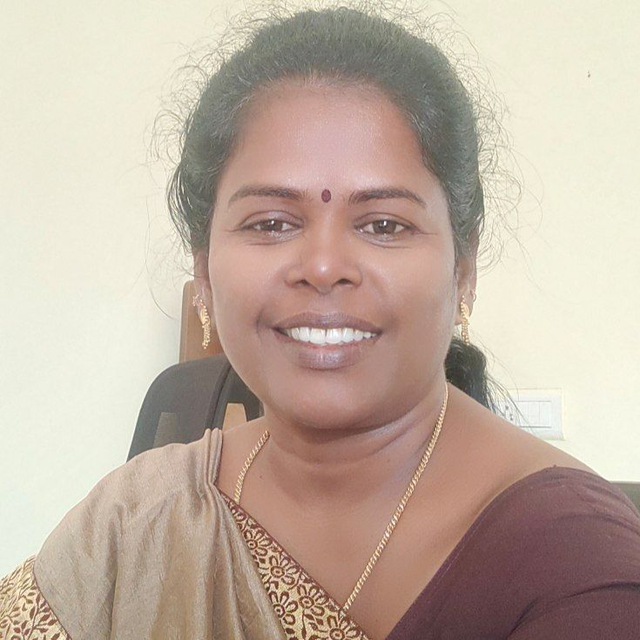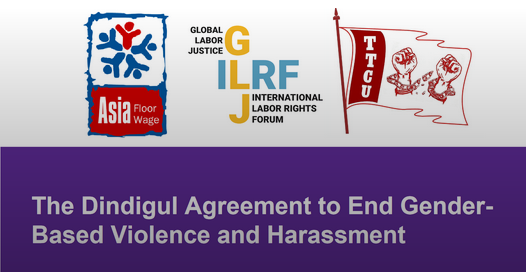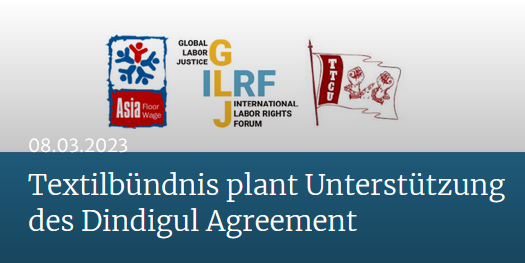Kapitel 6.5
Advancing Gender Justice in Asian Fast Fashion Supply Chains
One year of implementation of the Dindigul Agreement
Conversation with Thivya Rakini, President of the Tamil Nadu Textile and Common Labour Union (TTCU) and Nandita Shivakumar from Asia Floor Wage Alliance (AFWA).


Thivya Rakini


Nandita Shivakumar
The Dindigul Agreement has been signed in April last year. It has received quite a large media coverage and was termed a landmark agreement. What is special and different about this initiative, Thivya?
Thivya: The Dindigul Agreement is the first enforceable brand agreement in Asia, wherein brands (H&M, GAP, PVH) and one supplier factory (Eastman Exports) committed in a legally binding manner to address gender and caste-based violence and freedom of association in a garment production complex.
The agreement draws language from the ILO C-190, includes an innovative program known as “Safe Circles”, with regular trainings for all workers, supervisors and managers; a peer education program and shop floor monitors to detect and report gender-based violence and harassment (GBVH). It provides strong anti-retaliation protections against workers and shopfloor monitors for reporting grievances; strengthens India’s mandatory workplace GBVH committees (Internal Complaints Committee) by ensuring they are worker-led and have expert independent capacity; and creates independent grievance mechanisms with business consequences.
In short, the agreement provides a comprehensive set of tools that delivers power and support to women workers to monitor, prevent and remediate GBVH collectively and with management.
What is your view, Nandita. How is this agreement different from other projects and programs on women’s rights in the textile industry?
Nandita: As Thivya said, the Dindigul Agreement is quite different from existing programs in addressing gender rights in the garment industry. To add to what Thivya said, one of the most important features to me is that the agreement was drafted through a consultative process with women workers – so it reflects their experiences with GBVH and focuses on building their capacity and leadership in addressing GBVH.
Equally important to me is that it reflects the ILO labour standards (C-190, C-87, C-98) and addresses violence and harassment at the intersection of caste, gender, migration status. And finally, it recognizes that one-off trainings or grievance redressal tools like mobile apps alone cannot address GBVH. Workers require a comprehensive set of tools including strong anti-retaliation protections, freedom of association, independent and accessible grievance redressal mechanisms, regular training, and a process for social dialogue to be able to prevent and remediate GBVH.
The agreement has been in force now for a year. After one year of implementation can you already discern some positive impact on the factory floor, Thivya? What steps has Eastman Exports taken already and what has changed for women on the factory floor?
Thivya: Through the agreement, a process of social dialogue has been initiated between Eastman and TTCU, and we have been able to remediate 100+ grievances of workers within a year. These includes cases of gender-based violence, as well as other issues – like health and safety, access to social security, freedom of mobility, caste-discrimination at the workplace, etc. As the agreement stipulates regular meetings between TTCU and Eastman’s management – most of these grievances have been resolved within a 14-day frame. Also, I personally visit the factory at least twice a week, so that workers have direct access to the union, to raise grievances whenever they need.
We have completed basic trainings for all workers, management and contractors on the Dindigul Agreement and on GBVH. The Internal Complaints Committee (ICC) has been reorganized and strengthened, and the independent grievance redressal mechanism with assessors and the shop floor monitor system, has also started functioning. We have worked with Eastman to ensure that this apparel production complex provides freedom of mobility for all women workers staying at worker hostels. We believe Eastman is the only factory ensuring this in Dindigul.
We are currently working with Eastman on redeveloping management policies so that caste and gender-based violence are systematically addressed.
Despite numerous programs, initiatives and repeated calls for action, gender-based violence and harassment (GBVH) remains widespread in global supply chains of the fashion industry and little progress has been made so far. What are the barriers and obstacles to progress in India, in your view, Nandita?
Nandita: GBVH is an issue not just in India – but across garment production countries, and it is rooted in risks associated with brand purchasing practices, the concentration of a majority woman workforce in the lower tiers of supply chain production, poor working conditions, and lack of freedom of association in supplier factories. The downward pressure on prices by brands and increasingly unpredictable seasonal variation in production, require garment suppliers to employ a precarious, low-wage workforce. These terms of employment itself make women workers more vulnerable to GBVH.
This is why AFWA has been calling for a multifaceted approach to address GBVH. Brands must engage in human rights due diligence that identify gendered spectrums of violence and risk factors for GBVH using the C190 framework and take actions to mitigate adverse impacts; protect and promote women workers’ associational agency; and uphold binding accountability for C190 obligations by entering enforceable agreements across fast fashion supply chains.
There has been a lot of discussion about internal complaint committees (ICCs) which are mandatory in India. There are complaints about too many committees on different topics and that in reality they are not functioning. Why are they often not functioning and what does it need to make them work, Thivya? What is their role in the agreement?
Thivya: The ICCs are a result of a long struggle by the Indian women’s movement, and are definitely an important tool to address GBVH. However, they function poorly in most garment factories for multiple reasons.
Let me provide a few examples. Without a union in the factory, workers are scared to report grievances to the ICC as they fear retaliation from management. Worker members in the committee are themselves scared to investigate grievances raised by other workers fairly, as they fear management retaliation. Also, in many factories the independent member of the ICC is hired and paid by management – this affects their independence. And in some cases, workers don’t even know that the ICC exists and that they can raise grievances to it.
The Dindigul Agreement tries to address these issues. Firstly, it ensures that all workers and the management are aware of the roles and responsibilities of the ICC and its members. Secondly, it ensures that there are strong anti-retaliation protections, for workers who raise grievances and for ICC worker members who investigate grievances. It ensures that the ICC is primarily worker-led, with the majority of members being women and elected by the union. Thirdly, it creates expert capacity to investigate GBVH – as under the Agreement ICCs can delegate to a roster of independent expert assessors to investigate allegations of GBVH.
Finally, committee-recommended remedies are survivor focused. Upon receiving a complaint, ICCs and assessors are required to ensure worker safety and privacy. In case the ICC finds GBVH has occurred, Eastman must follow the committee-recommended remedies.
What are your expectations towards brand signatories? What is their role in the agreement, Nandita?
Nandita: Brands are responsible for the overall monitoring and enforcement of the agreement along with the labor signatories. Brand signatories are part of the Oversight Committee, which supervises the outcomes of the agreement, and receives reports from the Agreement’s independent grievance mechanism in case of Eastman’s non-compliance. If Eastman fails to comply with the Agreement, the brand signatories must take steps to impose business consequences; and if they fail to do so, labor signatories can take legal action, as the agreement with brands is subject to binding arbitration.
How do you see the future of the agreement? If you were to look back in 5 years’ time, what do you wish to have achieved by then, Thivya?
Thivya: We have seen many grievance redressal mechanisms in Tamil Nadu’s garment factories over the last two decades including grievance redressal apps, hotline numbers, GBVH trainings etc. They have all failed, as workers do not feel confident to raise their grievances through it. They fear retaliation from management or believe that their complaints will not be heard and addressed. Also, many efforts have failed as they do not engage with women workers as agents of change. This is what the union-led Dindigul Agreement has tried to change.
We hope in the next 5 years, this agreement is expanded to more factories in Tamil Nadu and beyond. We hope that more suppliers and brands are open to enforceable brand agreements. We hope in this way we will be able to empower more women workers to have a constructive voice at work, and we will be able to facilitate ongoing dialogue and collaboration between workers and management to address GBVH. We believe it to be the best safety net for workers and businesses to ensure what happened to Jeyasre will never be repeated.
Finally, what would be your message to Partnership member brands potentially interested in joining the agreement, Thivya and Nandita?
Thivya: We hope more brands will become signatories of the Dindigul Agreement. The Dindigul Agreement is the highest standard of commitment that any brand can take towards GBVH prevention and remediation in their supply chain. By being part of it, you are demonstrating that, as a brand, you prioritize the safety and security of women at your supplier factories and you ensure they have access to the best system to prevent and remediate GBVH, and any other forms of egregious violations. We hope that more brands understand this, and become part of the agreement.
Nandita: I completely agree with Thivya. We really hope more brands become signatories of the Dindigul Agreement. Brands must see enforceable brand agreements (EBAs) like the Dindigul Agreement as the roadmap to meet their legal obligations to achieve violence-free workplaces. By being a part of this agreement, they are sending a clear message that they will ensure safe and dignified workplaces for women workers in their supply chain.
Aktuelles
Indien: Erstes rechtsverbindliches Übereinkommen zu GBVH
Mit dem „Dindigul Agreement to End Gender-Based Violence and Harassment“ (GBVH) gibt es erstmals in der asiatischen Textilindustrie ein rechtsverbindliches Abkommen zur Beendigung sexueller Gewalt und Belästigung von Arbeiterinnen.


Aktuelles
Textilbündnis plant die Unterstützung des Dindigul Agreement
Ziel ist es, konkrete Verbesserungen für Frauen vor Ort zu erreichen und Arbeitsbedingungen zu schaffen, in denen sie keine Angst vor geschlechtsspezifischer Gewalt und Diskriminierung haben müssen. Dazu wollen die Beteiligten das Dindigul Agreement auf weitere Zulieferer in Tamil Nadu und gegebenenfalls darüber hinaus ausweiten.


Fokusthema Geschlechtergerechtigkeit
Lesen Sie hier mehr zum Textilbündnis-Fokusthema Geschlechtergerechtigkeit.